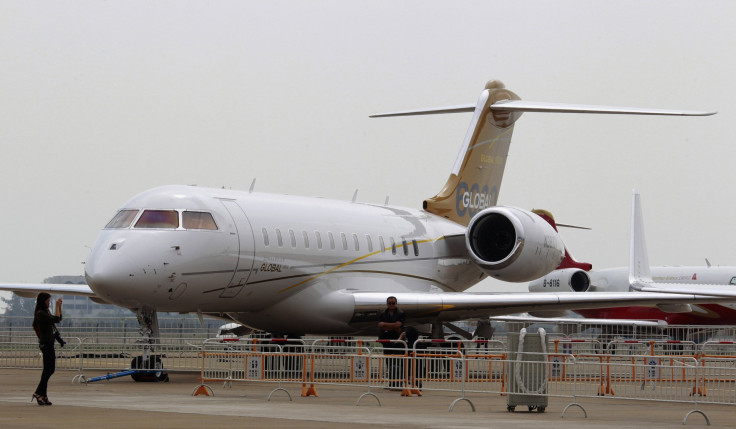Bombardier Sells Its Final Commercial Aircraft Program

In late 2017, Bombardier (NASDAQOTH:BDRAF) (NASDAQOTH:BDRBF) shocked the market by handing a controlling stake in its CSeries aircraft program -- now known as the A220 -- over to Airbus. While Bombardier had poured billions of dollars into developing the CSeries, which was supposed to be its main growth driver, the company's management team ultimately decided that competing with Boeing and Airbus was unwise.
This divestiture left Bombardier with two dated, low-volume product families in its commercial aircraft portfolio. Last year, CEO Alain Bellemare announced that the company planned to exit commercial aviation entirely. He fulfilled this promise last week, striking a deal to sell the CRJ regional jet program to Mitsubishi Heavy Industries (NASDAQOTH:MHVYF).
In conjunction with the sale agreement, the two companies announced that CRJ production will end next year. That's another piece of good news for regional jet titan Embraer (NYSE:ERJ).
A swift exit from a key market
In recent years, Bombardier has had four main lines of business: commercial aviation, business jets, rail equipment, and aerostructures (wings, fuselages, and other major aircraft parts).
The CSeries was intended to be the future of Bombardier's commercial aviation portfolio. As of two years ago, the unit's other two product lines were the Q400 large turboprop and the CRJ family of regional jets. However, those are aging models, each with just a few dozen remaining firm orders. Once Bombardier decided to give up its majority stake in the CSeries program, it became virtually inevitable that it would sell the rest of its commercial aviation business sooner or later.
Last fall, Bombardier agreed to sell the Q400 line to privately held Longview Aviation Capital for $300 million. That deal was completed about a month ago. The new management team is now scrambling to rebuild the Q400 order backlog, which currently stands at around 50 aircraft.
The final piece of the puzzle fell into place last Tuesday, when Bombardier announced that Mitsubishi Heavy Industries had agreed to acquire the CRJ program for $550 million. The deal is expected to close in the first half of 2020, after which Bombardier will focus its efforts on its stronger business jet and rail segments. (The aerostructures business is also up for sale.)
Mitsubishi makes another move to build up its regional jet credibility
A curious aspect of the CRJ sale is that both sides acknowledge that this aircraft program has no future. In recent years, it has become clear that airlines -- particularly in the U.S. -- vastly prefer Embraer's E175 jet over the competing CRJ900.
There were 51 orders remaining in Bombardier's backlog as of the end of March, and that total has continued to dwindle over the past three months. Under the terms of the sale agreement, the few CRJ jets left in the backlog after the deal is completed will be assembled by Bombardier on behalf of Mitsubishi Heavy Industries. Production will wind down by the end of 2020.
So why is Mitsubishi shelling out so much money for the CRJ program? The value of the deal comes from acquiring Bombardier's global sales and service network. For one thing, this should lead to a long stream of profitable aftermarket revenue.
Moreover, Mitsubishi is in the late stages of designing a clean-sheet regional jet of its own. Its SpaceJet M90 is scheduled to enter service next year, followed by its SpaceJet M100 regional jet for the U.S. market in 2023. The CRJ acquisition will enable Mitsubishi to skip what could have been a long and costly process of building up global sales, service, and support networks.
Embraer has a clear path for a few years
I have been pretty skeptical about the wisdom of Mitsubishi Heavy Industries' business plan. While the SpaceJet family should be more efficient than Embraer's offerings, Embraer already has a large customer base and a proven product: advantages that shouldn't be underestimated.
In the U.S. specifically, Embraer's strong position just improved further. Right now, the CRJ900 is the Embraer E175's only competitor in the U.S. regional jet market. Given that Bombardier and Mitsubishi Heavy Industries don't plan to try selling any more CRJ900s and the SpaceJet M100 won't be ready until at least 2023, the E175 will have a virtual monopoly in this market segment for the next few years.
By the time the SpaceJet M100 is ready, Embraer will have already captured a huge proportion of the total U.S. market opportunity. Outside of the U.S., regional airlines generally are able to operate planes with up to 100 seats, which makes Mitsubishi's offerings -- currently all in the 75-85 seat range in two-class configurations -- less desirable.
Buying a global services and support network may help Mitsubishi sell a few more SpaceJets. But it still may not allow the company to sell enough new planes to keep the facilities it is acquiring from Bombardier busy once airlines retire most of their aging CRJs.
Adam Levine-Weinberg owns shares of Delta Air Lines and Embraer. The Motley Fool owns shares of and recommends Delta Air Lines. The Motley Fool has a disclosure policy.
This article originally appeared in The Motley Fool.



















